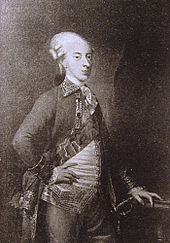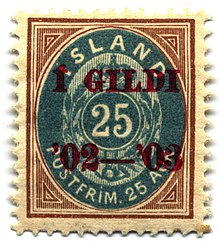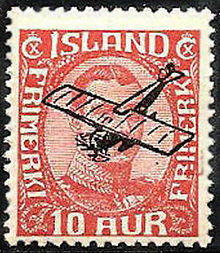Postal history and postage stamps from Iceland
The postal history of Iceland is closely connected to the former mother country Denmark due to Icelandic history . Nevertheless, today's republic in the far north issued its own postage stamps as early as 1873 .
Iceland under Danish rule
The beginnings of the Icelandic postal system
The beginnings of the Icelandic postal system (see Íslandspóstur ) go back to 1776. At that time Iceland was still under Danish rule . On May 13th of that year, the Danish King Christian VII had his own postal system set up on the island of Iceland. Two years later a ship's mail service was set up between the Danish capital Copenhagen and the largest city in Iceland, Reykjavík . Initially, there was only one ship per year. However, this connection has been steadily expanded and expanded. In 1858 there was regular shipping from April to November.
In Iceland, building a postal system based on the European model proved to be extremely difficult. Construction progressed faster on the more densely populated west coast than in the east. In 1831 it became possible to provide the population along these coastlines eight times a year by post. In 1849 the postal system finally extended over the whole island and was able to guarantee regular mail delivery. Several new post offices were opened outside Reykjavík during this period.
The introduction of the postage stamp
The postage stamp was introduced in Iceland in March 1870. These were Danish postage stamps, which from now on were also used in the Icelandic postal system. The Danish postage stamps showed the Danish crown , or from 1871 onwards, they were limited to a number drawing . The stamp issues were already perforated after the first Danish stamps from 1851 were still unperforated . The Danish postage stamps were initially only available at the post offices in Reykjavík and Seyðisfjörður . The Icelandic post offices still had simple number stamps at that time . These two post offices were assigned the numbers 236 and 237. Only on the basis of these numbers can stamps used in Iceland be distinguished from stamps used in Denmark.
After Danish stamps had been issued in Iceland for over two years, the government finally decided to have its own stamps produced for the island. On January 1, 1873, five different values were issued specifically for Iceland. These postage stamps were similar in their drawing to the Danish postage stamps from 1871. Some of the postage stamps were imperforated and only a few have survived. A watermark showing the Danish crown was incorporated into the stamp paper . The five values of 2, 3, 4, 8 and 16 Skildingar were the only ones in their currency, since a change from Rikisdalur to Krona took place as early as 1876 .
Previously, on July 1, 1875, he joined the Universal Postal Union together with Denmark.
The time until the end of the First World War
The following stamp series in Aurar and Krona still show a number drawing and are always based on the Danish stamp issues. These can be found up to 1902. At this time, the number stamps were also gradually abolished. At the end of this period, the postage stamps were imprinted with Í Gildi '02 –'03 in black or red . These were simultaneously with a new series of stamps with the portrait of King Christian IX. of October 9, 1902 and are to be understood as an additional temporary edition. Some of these values have only survived in a few pieces.
After the death of King Christian IX. In 1906 the new Danish King Frederick VIII graced Iceland's postage stamps. In 1911, however, a stamp issue was produced which referred to Iceland itself for the first time. To mark the 100th anniversary of the death of Jón Sigurðsson , a pioneer for Iceland's independence from Denmark, six postage stamps were issued showing his portrait. After the renewed change of the throne in 1912, there was initially no new stamp issue.
Denmark remained neutral during the First World War . In 1918 the union treaty was signed with Denmark. Iceland now joined the Universal Postal Union as a separate member state on November 15, 1919.
Kingdom united with Denmark
Despite the extensive independence from the Danish postal system since the First World War, the first post-war series of postage stamps once again graced the Danish king. In this case it was about King Christian X. , who - although he had ruled since 1912 - only received his own postal stamp series in February 1920. These stamps were to remain in use until the end of 1946. However, the beginning of the largely independent Icelandic postal system was also marked by numerous difficulties. In the 1920s, for example, numerous old remnants of invalid postage stamps had to be overprinted and reissued to compensate for bottlenecks. So it was that King Christian IX. and Jón Sigurðsson were once again featured on Iceland's postage stamps.
At the same time, the Icelandic airmail network was set up . This should bring about a significant improvement both within the country and for postal connections abroad. In 1928 the first Icelandic mail flights finally took place. These could be released with specially created airmail stamps. These were the usual postage stamps with the portrait of Christian X. with an airplane printed on it . Initially only the value of 10 aurar was overprinted, later also the value of 50 aurar.
The anniversary year 1930

In 1930 Iceland celebrated the 1000th birthday of the old thing . This special event should also be commemorated with a separate stamp issue. As early as 1928, the Association of Friends of Iceland from Vienna approached the Icelandic postal administration because of this anniversary. She suggested creating her own stamp commemorative series and giving it to Iceland as a gift. In return, the association should be allowed to keep a smaller number of these stamps. However, the responsible Icelandic postmaster Sigurður Briem had strong doubts about the seriousness of the offer and he tried to get the Icelandic parliament to reject the gift. Regardless of his objections, however, she accepted the gift and received stamps with a total value of 600,000 Kronur in December 1929. Allegedly, the remaining stamps with a value of 213,000 Kronur should have remained in Vienna. It soon became apparent that this amount could in no way correspond to the actual amount retained. Presumably, the production of postage stamps with a total value of 1,813,000 Kronur, i.e. more than double that, would have resulted in 1,213,000 Kronur stamps remaining in Vienna. However, police investigations had to be discontinued after several years without any results. The sale of the postage stamps is likely to have made a substantial profit for the Friends of Iceland Association .
Not only the history of their creation, but also the stamp issue itself is a special feature of Icelandic postal history. The main series of 15 values comes from the Elbemühl printing company in Vienna and was largely designed by Icelandic artists . The motifs show Icelandic landscapes and historical scenes as well as the country and the flag of Iceland. Previously, only five stamps with a comparable choice of motif were issued in 1925. Philatelists consider it one of the most beautiful and most elaborately designed postage stamps in the country. There are also six other airmail stamps for the occasion, showing planes in front of Icelandic landscapes and a falcon .
The road to the Republic of Iceland
On July 1, 1931, LZ 127 also visited Reykjavík. This special event in Icelandic airmail history was honored with a separate stamp issue. For this purpose, Christian X was again overprinted. This time, however, instead of an airplane, it was covered by the Zeppelin 1931 lettering . These postage stamps were intended for franking mail that was supposed to fly with the Zeppelin . This could happen without a zeppelin ever landing in Iceland. The mail was carried up in bags while the zeppelin waited at a suitable height.
The following period was marked by postage stamps that showed motifs based on the model of the Althing series. The postal system itself was also able to establish itself more and more. There were no bottlenecks or other problems like a few years earlier. Among other things, the first Icelandic charity stamps were issued in 1933 and the first Icelandic pad was issued in 1937 . This was issued on the occasion of the 25th anniversary of the king's reign. The next block edition followed just a year later.
The Republic of Iceland
The first years of the republic
During the Second World War , Iceland was occupied first by Great Britain in 1940 and later by the Americans . This did not have any major impact on the Icelandic postal system, but was reflected in the establishment of several field post offices by the occupiers. The British field post service in Iceland was discontinued in 1943. During this time, relations with the union partner Denmark largely broke off as it was occupied by the German Reich . During the World War, on June 17, 1944, the Republic of Iceland was proclaimed and it was completely separated from Denmark.
Sveinn Björnsson became the first president of the young republic . However, the Icelandic Post decided not to Björnsson, but to Jón Sigurðsson , who had appeared several times on Icelandic postage stamps, to dedicate the first stamp series to the Republic of June 17, 1944. Sveinn Björnsson only received his commemorative stamp after his death in 1952.
The development until today
The Icelandic postal system remained largely unchanged in the republic, but has been constantly expanded. Today Iceland Post Ltd. (Íslandspóstur) with almost 1200 employees one of the largest employers in the country. The motifs of the Icelandic stamp issues were largely spared political events , but current events such as volcanic eruptions were discussed. In general, almost all of the Icelandic Post's issuing program includes homeland-related motifs.
literature
- Bob Lamb: Republic of Iceland. In: American Philatelist July 2011 edition; from the series of articles / category Worldwide In A Nutshell
Web links
- Research Community of the Nordic States V.
- Icelandic Post Stamps
- Paul Herber's Icelandic stamps pages. Archived from the original on February 14, 2014 ; accessed on January 18, 2016 .
- Icelandic stamp booklets





